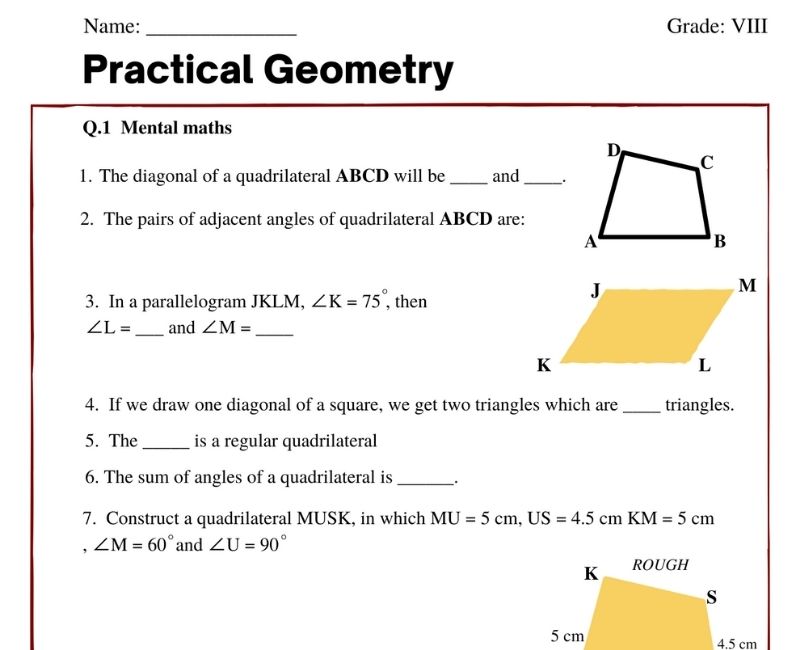Practical Geometry Class 8 Worksheet
Embark on a mathematical odyssey with the Class 8 Practical Geometry Worksheet, a comprehensive guide that transforms abstract geometrical concepts into an interactive, hands-on learning experience. It's the fourteenth chapter in the saga of Class 8 mathematics, where each page turns like a new chapter in a novel, brimming with lines, angles, and the mysteries of construction. As students immerse themselves in this adventure, they leave behind the realm of mere calculation and enter a world where geometry comes alive, offering a practical approach to understanding shapes, sizes, and the real-world applications of mathematics.
The intricacies of Practical Geometry Class 8 worksheets are thoughtfully crafted to cater to various aptitudes, ensuring that every student finds a foothold within its margins. These worksheets provide a plethora of problems that require the careful application of theorems and postulates, enabling students to not only learn but also apply the fundamental aspects of geometry. From crafting the perfect circle to bisecting angles with precision, learners come to appreciate the elegance and efficiency of geometric construction.
With the Class 8 Chapter Number 14 Maths worksheets, the journey through the lands of lines and circles becomes an illuminating experience. Students develop a kinship with compasses and rulers, the trusted tools that help them navigate this voyage and unlock the treasures of congruence and symmetry. The practical applications of these worksheets are boundless, equipping young mathematicians with the skills to approach and solve complex geometrical puzzles.
As the exploration advances, the Practical Geometry Class 8 PDF Solutions emerge as a lighthouse, guiding learners back to the shores of understanding when they drift amidst the seas of geometrical challenges. These meticulously detailed solutions offer students clear and concise explanations, shedding light on the step-by-step process of geometrical constructions, and providing a reliable reference to cross-check their work against.
When wielded effectively, the Class 8 Practical Geometry Worksheet becomes more than just a study aid; it's a compass for navigating the broader world, instilling a confidence in students that shapes their mathematical journey and beyond. With every line drawn, every angle measured, and every problem solved, learners are not just completing assignments—they're building the foundational knowledge that will anchor their future educational endeavors in logic, design, engineering, and architecture.
Practical Geometry Class 8
In Practical Geometry Class 8, students are introduced to the fundamental concepts of constructing geometric figures using simple tools. This chapter encompasses learning to draw precise lines, angles, triangles, and circles, applying geometric principles and theorems in real-world scenarios. It develops critical thinking and encourages hands-on application, enhancing students' understanding and appreciation of geometry as an essential mathematical discipline.
Learning Objectives of Practical Geometry Class 8
The learning objectives of Practical Geometry in Class 8 are aimed at equipping students with the ability to understand and construct geometric figures using basic tools. This includes gaining proficiency in drawing lines, angles, and shapes, understanding the properties of geometric figures, and applying theorems and axioms in practical situations. It fosters critical thinking and problem-solving skills by encouraging learners to visualize and execute complex constructions. By the end of the course, students should be able to confidently tackle real-world geometric problems, thus laying a solid foundation for future mathematical learning and applications.
Practical Geometry Class 8 Worksheet
Practical Geometry Class 8 Worksheets are meticulously designed to guide students through the intricate world of geometric constructions. These worksheets provide a variety of exercises that require the application of geometrical concepts and the use of tools such as the compass, ruler, and protractor. Through engaging in these activities, students practice constructing angles, bisectors, perpendiculars, and various types of triangles and quadrilaterals. These hands-on tasks not only enhance their understanding of geometric principles but also improve their precision and accuracy in drawing, serving as a vital component of their mathematical education.
Practical Geometry Class 8 Extra Questions with Answers
Practical Geometry Class 8 Extra Questions with Answers serve as an invaluable resource for students seeking to deepen their understanding of geometric principles. These questions challenge learners to apply their knowledge in more complex situations, extending beyond the standard curriculum. With answers provided, students have the opportunity to self-assess their work, learn from their mistakes, and gain insights into various methods of problem-solving. This additional practice is instrumental in refining students' skills, helping them to master the art of geometric constructions with greater confidence and proficiency.
Practical Geometry Class 8 MCQ
Multiple Choice Questions (MCQs) in Practical Geometry Class 8 offer students a unique and efficient way to test their understanding of geometric concepts. These questions cover a wide range of topics, from basic constructions to more advanced applications of geometrical theorems. MCQs help learners to quickly gauge their grasp of the subject matter, encouraging them to think critically and select the most accurate answer amongst several options. This format also prepares students for exam situations, improving their time management skills and their ability to make informed decisions under pressure.
Practical Geometry Formula
In Practical Geometry, formulas play a vital role in simplifying the process of constructing and understanding complex geometric figures. Key formulas that students encounter include those for calculating the areas and perimeters of squares, rectangles, triangles, and circles. Understanding and applying these formulas enables students to accurately construct geometric shapes and solve related problems efficiently. Mastery of these formulas is essential, as they not only aid in practical geometry tasks but also form the basis for more advanced mathematical studies, including algebra and trigonometry.





